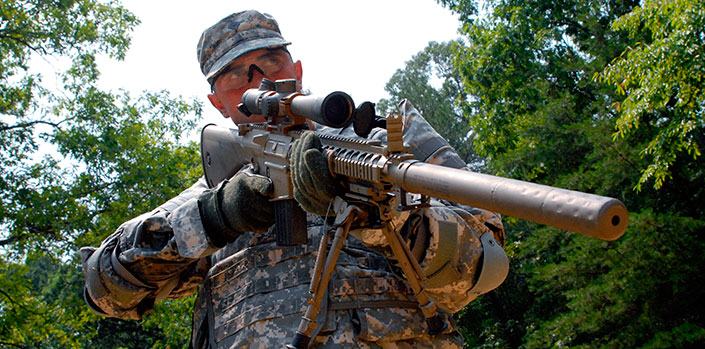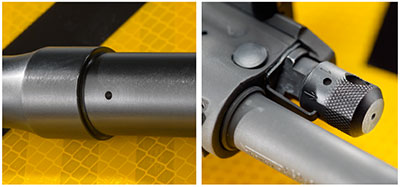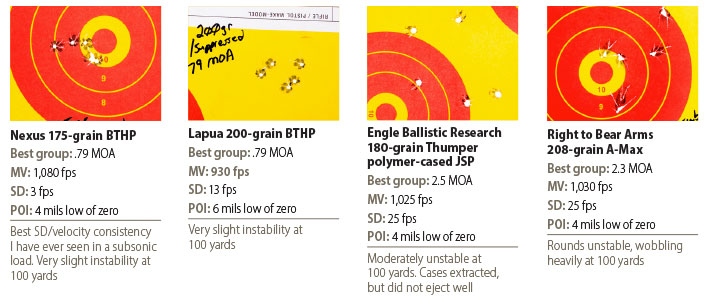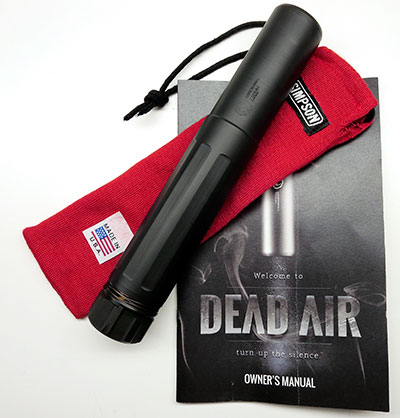
I am lying behind my Knight’s Armament SR-25 on a cold, wet autumn night. Rain-soaked fatigues and fogged optics are minor burdens compared to my other troubles. My sniper buddy crouches low over me, watching the big picture around us through his night-vision goggles while my attention is on the head and shoulders of a threat target 165 meters away. Our task is to silently neutralize him with a central-nervous-system (CNS) shot. This would be a simple job at this distance, but we have a new and untested tool in our kit this night: subsonic match ammunition. That we are shooting it for only the second time in our lives makes things particularly tricky. Our goal is to ensure the assault force—which happens to be between us and the target—can get into position without being compromised by the roving guard that holds my attention at the moment. It is the mid-1990s, and we are new to the subsonic 7.62 NATO-ammunition game. The only data we have for our rounds’ trajectories is at 100 and 200 meters, and unlike supersonic ammo, this stuff is wholly unpredictable at any distance not previously confirmed. Slight miscalculations in elevation adjustment equal misses measured in feet at this distance. Under the circumstances, making a daytime subsonic CNS shot would be difficult enough, but we do our best work at night and so here we are.

Hand-held ballistic programs are just a figment of someone’s imagination at this point, so we are truly without any useful data. Fortunately, this is a training hit and our bad guy is a partially exposed “Iron Maiden” target. Even so, this is the full dress rehearsal for a real-world mission we are on standby to launch any day. The pressure to succeed is high, but the fact that live, friendly operators are positioned between us and the target raises the stakes to “no fail.” My partner ensures the line of fire is clear while we quietly develop the firing solution together. After applying some idiot math, educated guesswork and a couple prayers, we agree on “dope” that we think will splatter the 185-grain, T-base, FMJ bullet 1-inch high of center mass, just to be safe. I get back on target through my night scope and break the shot at the appropriate time. The report is much like that of an air rifle, and after a pause long enough to make me sweat, we are rewarded with a very deep gonnnnnnnnng sound that starts the show right on cue.
Such early attempts to integrate subsonic ammunition into suppressed sniper shooting were very frustrating due to limited ammo choices and inconsistent performance. They did not always work out as well as my first experience did. Thankfully, the shooting industry has since progressed to the point where the once barely understood niche of subsonic/suppressed rifle shooting is now a mainstream concept in a growing crop of useful calibers.

When fired within the temperature ranges for which it was loaded, subsonic ammo leaves the barrel moving slower than the speed of sound. That means these rounds can be ridiculously quiet when combined with a suppressor. Some loads are quieter than the metal-on-metal sound of the action cycling for each shot. However, subsonic rounds are not truly silent—some gasses follow the bullet out of the bore and objects moving through the air make noise, too. But subsonic fodder is easy on the ears to the degree that hearing protection is overkill, neighbors remain friendly and nearby animals do not spook.
Subsonic loads use much less powder, so less fouling builds up compared with supersonic ammo, especially when using a suppressor. Light, single-shot subsonic loads—those not designed to operate a semi-automatic—are the cleanest, limiting most fouling to the bore and bolt face regardless of a rifle’s operating system. Even functioning semi-autos send less crud out through the ejection port, sparing shooters from wearing the usual carbon freckles. Unlike the 2- to 3-MOA fodder we fired a couple decades ago, many current subsonic loads are capable of excellent accuracy. I routinely get sub-MOA performance from various slow-movers in .300 BLK, 7.62x39 mm and .308 Win. at 100 yards.

Unfortunately, several characteristics of subsonic ammunition make the learning curve a bit steep when getting started. It is not at all uncommon to hear that telltale supersonic crack of what should have been a subsonic projectile as it moves downrange faster than expected. A number of factors contribute to this occasional problem, but temperature changes are the usual cause. The speed at which sound travels in air changes as atmospheric conditions—most notably air temperature—change. As the speed of sound decreases in cooler air, a cartridge loaded to send its bullet out at a specific speed can wind up above the speed of sound and go supersonic. These days, most ammo manufacturers fudge things to the slow side just to be safe, so the problem is not as common as it used to be.
Another suppressed-shooting phenomenon that becomes noticeable with subsonic ammo is that the first shot through a cold suppressor is often louder than those that follow in a relatively short time-span. This has to do with the baffles inside the suppressor being cold and the spaces devoid of gasses until a shot is fired. After that, things settle down a bit and follow-up shots sound quieter.

Reliable semi-auto rifle operation used to be rare when shooting subsonic ammo. These reduced-powder loads generate less available gas pressure than what is needed to cycle a rifle’s action. While sound suppressors help keep some pressure bottled up in the barrel and gas system longer, gas port sizes in most factory rifle barrels are simply not large enough to make use of the pressure before it dissipates. While opening the barrel’s gas port can fix the problem with some cartridges, too much gas often causes malfunctions when supersonic ammunition is used in the same gun.
J.D. Jones, of SSK Industries, was the first person I met who had successfully addressed this problem by attacking it from two directions. First, he created a whole line of Whisper cartridges specifically designed and loaded to be quiet and consistent, and deliver useful payloads. The most notable of these was the .300 Whisper, which was the model for today’s popular .300 BLK. Jones also knew an adjustable gas system is the key to making semi-automatic guns run reliably with both subsonic and supersonic loads. I remember at the time—1999 or so—thinking this was not viable on a fighting gun. I see things much differently now. The aftermarket provides several good, adjustable AR gas blocks that are well up to the task of being used on a combat firearm. Coupled with centerfire ammo specifically loaded to drive a semi-auto’s action, adjustable-gas systems allow shooters flexibility. So far I have found factory loads in 5.56 NATO, .300 Whisper/.300 BLK and 7.62x39 mm that run my semi-automatic rifles reliably.

Projectiles for these loads tend to run heavy and long for their caliber in order to increase the remaining pressure in their rifles’ operating systems while staying subsonic at the muzzle. A byproduct of these longer lengths is that they need tighter-than-normal twists to stabilize for reasonable distances. Even in normal weights and lengths, slow-moving bullets can be on the ragged edge of stability at conventional-barrel twist rates. This trend is pushing savvy gun and barrel makers to offer tighter-than-usual twists in calibers most commonly used for subsonic shooting. For example, a 1:10-inch twist rate has been favored for tactical shooters in .30-caliber guns for many years, but many longer bullets do not stabilize well with that twist rate, so tighter rates like 1:8-inch are increasingly common. Some accuracy may be lost on the lighter-projectile end of the supersonic spectrum, but the trade-off is usually worth it and does not affect the most popular bullet weights. I have built .300 BLK and 7.62x39 mm rifles with 1:8-inch twists that stabilize 208- to 220-grain subsonic loads, as well as supersonic projectiles in the 115- to 125-grain range.
Bullet designs have also adapted to deal with performance issues brought on by slower speeds. Traditional expanding bullets need a specific velocity on impact to “open up” as designed—they were designed with supersonic speeds in mind and do not always make a smooth transition to subsonic use. Fortunately, projectile technology has come a long way since the days when long, round-nose, soft-tip bullets were preferred for terminal effectiveness. Examples may be found in Lehigh Defense’s Maximum Expansion Technology bullets and Engle Ballistic Research’s Reaper projectiles. Both radically new designs are intended to expand well in tissue throughout a wide range of velocities.
Bullet design also affects accuracy. Slowing down a bullet that was engineered for accurate supersonic flight does not yield the best results. Therefore, adjustments to shape, bearing surface and weight distribution can be made to account for differences in the way these slow-movers deal with the pressure placed on them as they move through the air.
Back when I relied on this stuff for specialized sniper missions, I could accept hand-cycling my semi-automatic rifle because there was no reliable alternative, but muzzle velocities of the ammo at that time were very inconsistent. In addition to point-of-impact deviations caused by shooter error, loose-fitting suppressors and the projectiles used, we had a heck of a time dealing with horrendous vertical stringing on target. Chronographing different factory loads showed wild extreme spreading of velocities.
The chief culprit seems to have been excess case volume in legacy centerfire rifle cartridges. A subsonic .308 Win. load may have half (or less) powder by volume than a supersonic load. All that unfilled space leaves room for the powder to be in different positions from one shot to the next, especially in an active environment. Any inconsistency from one cartridge to another at the time of ignition translates to POI changes downrange. All sorts of ways to mitigate this problem have been tried, including special, expensive brass and aluminum, limited-capacity cases. Different shooter techniques to settle the powder consistently for each shot were also attempted. Improvements in consistency were minimal, regardless of the method used to tighten up muzzle velocities.
Powder technology and cartridge/projectile design all help reduce the velocity problems of old. Again, the .300 Whisper/.300 BLK shines as an example here, because it makes maximum use of a small parent case necked out to .30-caliber, so excess case volume is not much of a problem. Likewise, more conventional chamberings are coming on line to provide good performance at subsonic velocities. Recently, I tested five subsonic .308 Win. loads out of a 16-inch-barreled AR to see how much better things are than they were back in the old days. As a control, I first fired one suppressed group each of surplus M80 ball and Hornady 168-grain A-Max through my rifle’s 1:10-inch-twist barrel. The M80 gave me a five-shot, 1-MOA group and the Hornady turned in a sub-.75-MOA group. The results provide a quick snapshot of grouping and velocity consistency. I fired two each, five-round groups per ammo type at 100-yard targets and checked muzzle velocity using a Magnetospeed Barrel Mounted Chronograph.
Even the worst-shooting of those loads grouped at least as well as the stuff we used 20 years ago in the Army. The best of those tested—Nexus and Lapua—did exceptionally well for subsonic loads. Incidentally, I shot thousands of rounds of that same 200-grain Lapua subsonic load while in the service, so either the company has vastly improved its game or I am a way better shooter nowadays. (Go ahead and bet on Lapua.)

If you plan to only shoot your rifle with subsonic ammo, you can find out what it likes best, zero to that ammo, verify drop at other distances and then leave it alone. But dope management gets tricky if you plan to switch from supersonic to subsonic and back. Points-of-impact in my brief .308 Win. subsonic test ranged from 4 to 6 mils below my suppressed/supersonic zero. I used a mil-based reticle to adjust for the offset because it is fast and reliable, but you could dial-in the additional elevation if need be. Just remember to adjust it back to zero when switching back to regular ammo. Holding over your intended POI by eyeball is not the way to go here. Keep in mind that the drop I recorded was only at 100 yards. The deviation from normal zero increases exponentially for the bigger, marginally stable subsonic projectiles at longer ranges. This ammo is best used for short to moderate distance hunting or tactical needs and in all cases, you must get out and verify actual drop data at whatever distances you intend to shoot.
When shooting subsonic loads, it is important to be certain each and every round leaves the bore. I have seen two occasions where subsonic loads hung up in rifle bores due to insufficient-powder loads. Thankfully, in each case the shooters knew something was wrong and did not fire another round. Unlike squibs with supersonic ammunition, subsonic loads can be quiet enough that it does not sound much different. Because the sound of an impact into a target and/or berm is so noticeable, however, an absence of that sound stands out. I always verify each subsonic round has left the bore via sound and sight (holes in target) before I fire the next.

I check my barrel/muzzle device/suppressor alignments using Geissele Suppressor Alignment Rods, but that does not totally eliminate the potential for suppressor baffle strikes with unstable projectiles. It is important to periodically check to ensure your slow, long, possibly wobbly bullets are not grazing suppressor baffles. Whenever I shoot a new subsonic load, I remove the suppressor every few shots to inspect it inside and out before proceeding. If you strike a baffle or otherwise damage the suppressor, stop using it and contact the manufacturer for guidance.
Overall, I am impressed with the state of subsonic rifle ammunition today. I suspect we are going to see the catalog of available slow-moving, quiet loads grow as sound suppressors continue to make their usefulness known on all manner of firearms and shooters realize the merits of truly quiet ammo.
 Dead Air Armament Sandman-L Silencer
Dead Air Armament Sandman-L Silencer
I have had my hands on many new suppressors over the past year. I got more time with the Dead Air Armament Sandman-L 7.62 mm suppressor than most others during the course of my subsonic .308 Win. comparison. It is neither the shortest nor lightest .30-caliber silencer at 8.9 inches and 21.8 ounces, but the 1.5-inch outer diameter is smaller than many competing designs. This suppressor’s QD mount is among the best I have used and since there is no latch at the rear, the sleek can will fit under many freefloat fore-ends. Three teeth in the suppressor’s rotating collar pass through key slots on the included suppressor mount, and then cam into locking position, like a bolt’s locking lugs once the suppressor body is rotated clockwise. Very audible and tactile clicks let you know you are engaged, but I liked that I could see the teeth locked from the rear, too. If you shoot this suppressor off your gun, it is your fault entirely. All Sandman models are Cerakoted, rated up to .300 Win. Mag. and retail between $849 and $1,199 (tested). The Sandman-L performed well for me with numerous supersonic and subsonic loads, and I would not hesitate to rely on it in a pinch.
Sound Math
While it may not seem too useful, calculating the speed of sound through air will give you a fair idea of whether or not your subsonic ammunition will remain so as the thermometer drops—provided you know your load’s muzzle velocity to start with. You will need to convert the ambient temperature to degrees Centigrade for this to work:
“V” is the speed of sound in air and yields an answer in fps. “C” is the temperature in degrees Centigrade. An example: Air temp of 60 degrees Fahrenheit converts to 15.5 degrees Celsius.
The above formula gives us 1,118 fps as the speed of sound. So all else being equal, if your bullet leaves the bore slower than that speed, it will remain subsonic. But if the temperature at which you are shooting is much cooler, say 32 degrees Fahrenheit, sound will move more slowly at approximately 1,088 fps. Any rounds you fire with a muzzle velocity of 1,088 fps or faster will be supersonic, even if they are subsonic in warmer climates. Now you know.





































